Post by Jack Napier on Jul 23, 2008 0:24:38 GMT -5
And here...we.....GO!
(Posted this over at www.batmanmovieonline.com/forum/index.php?topic=281
and anjow1060.proboards74.com/index.cgi?board=discussallthingstdk&action=display&thread=1120&page=1)
EvilTwin120, the BOF poster who played a huge role in bringing the B89 Influences thread to life, cited this one:
www.batman-on-film.com/a-jokers-dozen-part10_rreineke_7-5-08.html
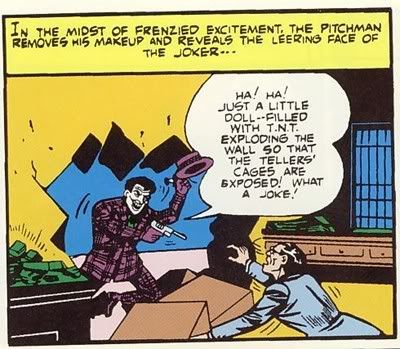
The scars on Bruce's back, like in Begins, have been established in the comics.
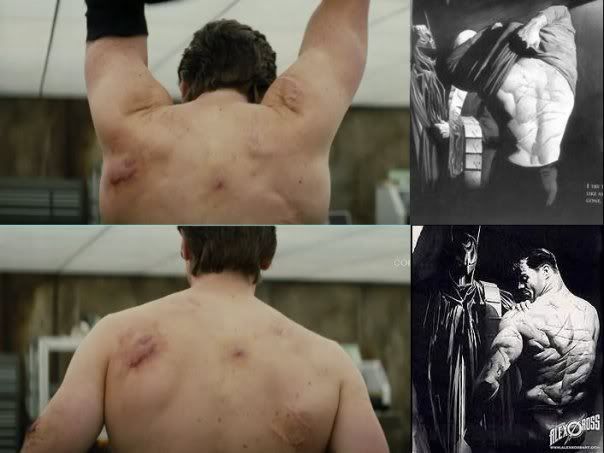
Harvey cites the double-sided coin as his father's lucky coin. Those in-the-know may read a darker side into that line considering that, in stories like Eye of the Beholder, Crime and Punishment, and The Long Halloween, Harvey's father used to beat him as a kid using the trick coin. Harvey lost the coin toss and his father always beat him.
Also, in that scene, Albert Rossi tries to shoot Dent. This may be a slight nod to the Two-Face origin in the comics in which Boss Maroni assaulted Dent in court by throwing acid in his face. In Eye of the Beholder, Maroni requests a gun to be smuggled in, but since it wouldn't be able to go through the metal detectors, he is given the acid, instead.
In the 1970s comics, Bruce Wayne also had a penthouse apartment in Gotham.
Both Eye of the Beholder and The Long Halloween establish Harvey Dent, Jim Gordon, and Batman as a powerful triumvirate against criminals. In both, Batman disappears after his first rooftop meeting with Harvey. In The Long Halloween, Gordon addresses Harvey's shock by saying, "He does that."
The line, "I believe in Harvey Dent," is right out of The Long Halloween.
The Long Halloween also had Two-Face bald on the scarred side of his face. For a majority of the comics, Two-Face's hair is simply a different color on the other side.
Like Batman Begins, and I found this unexpected, is that there is a lot of Batman Year One in here, particularly the ending of Year One.
In that, Bruce Wayne goes out on a motorcycle (similar to what he does during Commissioner Loeb's funeral) as mobsters (under the comic book Commissioner Loeb's orders) kidnap James Gordon's son and take his wife hostage. Later, the fight moves off to a bridge and, while Gordon is fighting a mobster, Gordon's son is dropped and Bruce moves in to save him.
The film carried over putting Gordon's family in danger and bringing Batman to a rescue.
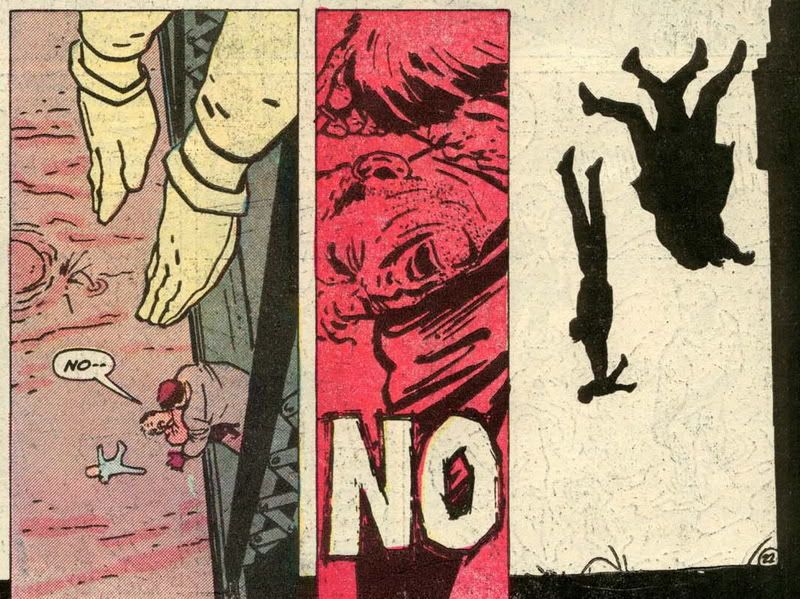
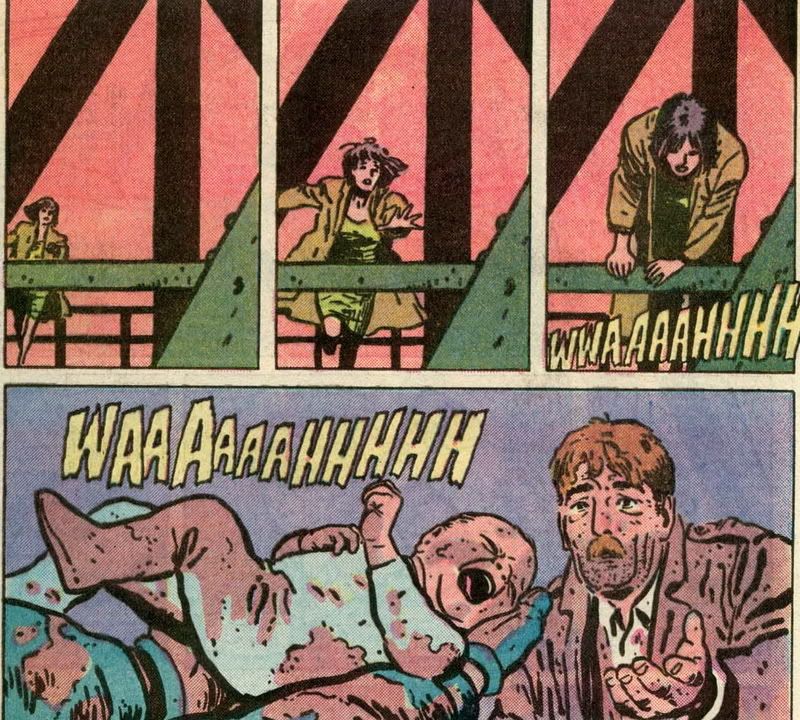
The sonar device that tapped into all cell phone conversations was inspired by the Brother Eye satellite that Batman established in the OMAC storyline. This was confirmed in a podcast interview with screenwriter Jonathan Nolan, which you download at the following link:
creativescreenwritingmagazine.blogspot.com/
And last but not least, I'm sure people are curious about The Joker.
This Joker, like Nicholson's, took cues from Batman #1. He also announced his intended crimes on the airwaves.

He disguised himself as a police officer to make a kill, as well as planted poison to kill off a police official. In the comic, he puts a poison dart or needle, I believe, in the phone. When the police chief picks up the phone, the Joker laughs loudly. The sound vibration then makes the chief exposed to the poison.
Also, like in Burton's Batman, this film was very influenced by The Killing Joke. The main premise of that comic is that Joker wants to prove that it only takes one bad day to turn the sanest man into a lunatic like him. He tortures James Gordon and tries to drive him insane, but he fails, whereas in The Dark Knight, his ideology succeeds in swaying Harvey Dent to the dark side. The Joker's dialogue at the end about Dent is very much in line with what the Joker says to Batman in the comic.
Also in that comic, Joker says that if he were to prefer a past, he'd pick multiple choice. As does this Joker in the film, who gives two contradicting backstories on how he got his scars. The first was about an abusive father, which was also a fake story used by the Joker to gain Harlene Quinzel's sympathy in Mad Love. It was revealed in that comic that Joker made up fake stories to gain sympathy from other officials.
The second backstory states that the Joker was previously married, which he also was in The Killing Joke.
Now, something that could have been an influence was Grant Morrison's take on Joker back in 2006 with Batman #663, The Clown At Midnight. It not only have Joker establish the cut smile, but it also has a line of dialogue very similar to what Joker says in the movie in which he looks at why they won't kill each other:
Okay, I'm sure I probably forgot a few things, but I thought I'd just start from there.
(Posted this over at www.batmanmovieonline.com/forum/index.php?topic=281
and anjow1060.proboards74.com/index.cgi?board=discussallthingstdk&action=display&thread=1120&page=1)
EvilTwin120, the BOF poster who played a huge role in bringing the B89 Influences thread to life, cited this one:
www.batman-on-film.com/a-jokers-dozen-part10_rreineke_7-5-08.html

The scars on Bruce's back, like in Begins, have been established in the comics.

Harvey cites the double-sided coin as his father's lucky coin. Those in-the-know may read a darker side into that line considering that, in stories like Eye of the Beholder, Crime and Punishment, and The Long Halloween, Harvey's father used to beat him as a kid using the trick coin. Harvey lost the coin toss and his father always beat him.
Also, in that scene, Albert Rossi tries to shoot Dent. This may be a slight nod to the Two-Face origin in the comics in which Boss Maroni assaulted Dent in court by throwing acid in his face. In Eye of the Beholder, Maroni requests a gun to be smuggled in, but since it wouldn't be able to go through the metal detectors, he is given the acid, instead.
In the 1970s comics, Bruce Wayne also had a penthouse apartment in Gotham.
Both Eye of the Beholder and The Long Halloween establish Harvey Dent, Jim Gordon, and Batman as a powerful triumvirate against criminals. In both, Batman disappears after his first rooftop meeting with Harvey. In The Long Halloween, Gordon addresses Harvey's shock by saying, "He does that."
The line, "I believe in Harvey Dent," is right out of The Long Halloween.
The Long Halloween also had Two-Face bald on the scarred side of his face. For a majority of the comics, Two-Face's hair is simply a different color on the other side.
Like Batman Begins, and I found this unexpected, is that there is a lot of Batman Year One in here, particularly the ending of Year One.
In that, Bruce Wayne goes out on a motorcycle (similar to what he does during Commissioner Loeb's funeral) as mobsters (under the comic book Commissioner Loeb's orders) kidnap James Gordon's son and take his wife hostage. Later, the fight moves off to a bridge and, while Gordon is fighting a mobster, Gordon's son is dropped and Bruce moves in to save him.
The film carried over putting Gordon's family in danger and bringing Batman to a rescue.


The sonar device that tapped into all cell phone conversations was inspired by the Brother Eye satellite that Batman established in the OMAC storyline. This was confirmed in a podcast interview with screenwriter Jonathan Nolan, which you download at the following link:
creativescreenwritingmagazine.blogspot.com/
And last but not least, I'm sure people are curious about The Joker.
This Joker, like Nicholson's, took cues from Batman #1. He also announced his intended crimes on the airwaves.

He disguised himself as a police officer to make a kill, as well as planted poison to kill off a police official. In the comic, he puts a poison dart or needle, I believe, in the phone. When the police chief picks up the phone, the Joker laughs loudly. The sound vibration then makes the chief exposed to the poison.
Also, like in Burton's Batman, this film was very influenced by The Killing Joke. The main premise of that comic is that Joker wants to prove that it only takes one bad day to turn the sanest man into a lunatic like him. He tortures James Gordon and tries to drive him insane, but he fails, whereas in The Dark Knight, his ideology succeeds in swaying Harvey Dent to the dark side. The Joker's dialogue at the end about Dent is very much in line with what the Joker says to Batman in the comic.
Also in that comic, Joker says that if he were to prefer a past, he'd pick multiple choice. As does this Joker in the film, who gives two contradicting backstories on how he got his scars. The first was about an abusive father, which was also a fake story used by the Joker to gain Harlene Quinzel's sympathy in Mad Love. It was revealed in that comic that Joker made up fake stories to gain sympathy from other officials.
The second backstory states that the Joker was previously married, which he also was in The Killing Joke.
Now, something that could have been an influence was Grant Morrison's take on Joker back in 2006 with Batman #663, The Clown At Midnight. It not only have Joker establish the cut smile, but it also has a line of dialogue very similar to what Joker says in the movie in which he looks at why they won't kill each other:
You can't kill me without becoming like me. I can't kill you without losing the only human being who can keep up with me. Isn't it IRONIC?!
Okay, I'm sure I probably forgot a few things, but I thought I'd just start from there.

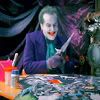
 Wow; I can't believe I can't come up with anything substantial...
Wow; I can't believe I can't come up with anything substantial...